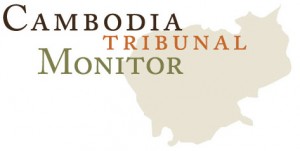Ruos Nhim’s Messenger Testifies
Today, witness Sem On concluded his testimony by telling the court about the coup d’état that had potentially been planned by Oeun and other cadres, as well as by giving evidence to the arrest and purge of East Zone cadres and their families. Next, anonymous witness 2-TCW-1036 testified about his role as one of Ruos Nhim’s messengers. Under questioning of the Defense Team he talked about Ruos Nhim’s arrest, as well as possible connections from the latter and other cadres to Vietnam.
Disappearance of Cadres and their Families
At the beginning of the session, the floor was given to the Co-Prosecution to conclude their line of questioning to examine Sem Om. Senior Assistant Prosecutor Lysak asked about Oeun’s arrest and wanted to know whether at the time many ordinary combatants disappeared. He said that many people disappeared when he was at Doung Prachat. “We were in constant fear at that stage”.
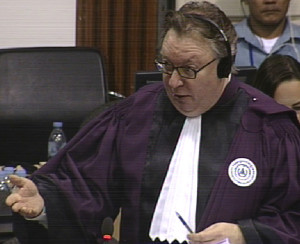
International Senior Assistant Prosecutor Dale Lysak
The wives and children of senior people were gathered to live in one place. Some of the wives had children. He did not know what happened to them later on.
Mr. Lysak said some wives of the division cadres were to be found on the OCIJ Prisoner list of 31 December 1976.[1] Mr. Lysak read out a range of family members (for example Oeun’s wife and father; Voeun’s wife) and asked whether he was aware of any family members being arrested. He said that he did not know when they disappeared.
Coup d’état
Mr. Lysak then wanted to know about the secret document that allegedly laid out support by the United States and asked the name of Oeun’s messenger who had told him about this. He answered that he could not recall the name. Mr. Lysak asked whether this secret document may have been a confession. He had heard of the secret weapons and uniforms. He said that there were, for example, ten uniforms per unit. After Ta Oeun was arrested, however, “it became quiet”, he said. At the time, there was a meeting and the messengers were sitting outside. It was a “chitchat conversation” when the messenger told him about this document. Weapons and uniforms were stored in a house opposite the propaganda office. This belonged to Regiment 13. He only went there once. Uniforms were piled into packages. On each pile, there was a note specifying the battalion that they were for. After they finished arranging the uniforms, they closed the door. He “simply followed the words” that people were saying.[2] He confirmed that at the time when he saw these uniforms, he did not know anything about a traitorous plan.
Khieu Samphan
He recounted that there was an assembly to which he was appointed as a guard. Someone made an appeal at the time to “rise up to join the revolution in order to defend the country.” They wore black uniforms. It took place at Ta Mom Village “We did not allow anyone in the area”. Mr. Lysak read an excerpt and asked whether Khieu Samphan was with Hu Nim and Hou Yuon.[3] He said that he could recall the presence of the two latter cadres.
There were people who were handicapped. “Those people could stay outside the revolution. This prompted Mr. Lysak to his DC-Cam statement, in which he had said that people were forced to join the revolution. [4] He replied that they “urged” them to join the revolution.
He saw that East Zone soldiers were transported in three vehicles. He asked Nam about it, who told him that the vehicles were “transporting the traitorous people”. He saw them blindfolded with kramas, and “there was also blood”. He saw the soldiers being pushed out of the vehicle. An hour later, Nam came back. They were transported to a house and gathered for a meeting. There were guards who pointed guns at them.
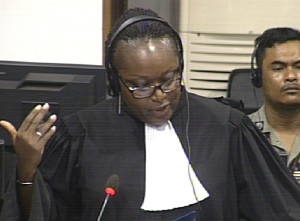
Khieu Samphan Defense Counsel Anta Guissé
Khieu Samphan Counsel Anta Guissé objected and said that this seemed to be outside the scope of the trial. Mr. Koppe conquered with this and said that the purges of East Zone soldiers was only included when they “ended up” at one of the security centers. The objection was overruled. It was a special unit. “That special unit was in charge of purging”. He called it the “purging unit”. This unit was part of Division 310. He did not see the wives and children of the East Zone soldiers.
He was assigned to guard Vietnamese prisoners at an office. He was told that he had to guard them one night, before they would be sent further. “They told me that they would be sent to be interviewed”.
Marriages
The floor was granted to the Civil Party Lead Co-Lawyers, who wanted to know when his supervisor Horn married. There were marriages between cadres and disabled people. After the liberation in 1975, he heard that marriages took place in Svay Teap. Ry, Phon’s wife, was from another region and they got married in Svay Teap. The disabled soldiers got married in a ceremony in which four or five couples were married. In his unit, only Keam – who had lost a leg – got married. Svay Teap wasin Chamkar Leu, Kampong Cham Province. They got married to produce children. From what he observed, he did not stay together with his wife all the time. Sometimes his wife came to stay for one night or two. There were no women where he was based. Combatants did not have the right to marry. “Only cadres and disabled soldiers were allowed to marry”.
Killing of Wives of East Zone Soldiers
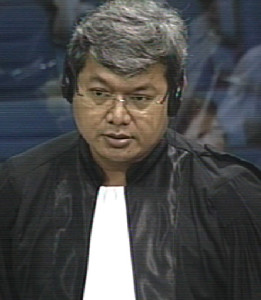
National Civil Party Lead Co-Lawyer Pich Ang
Mr. Ang then inquired about “an event” that happened at Suong Pagoda in Tboung Khmum. He replied that he was wounded and hospitalized at the pagoda. Ms. Guissé objected to this question. The objection was overruled, but the presiding judge Ya Sokhan informed him that he had only one question left. [5] When Mr. Ang asked about arrest and execution of women, Khieu Samphan Defense Counsel Anta Guissé objected again and said these facts were not mentioned in the severance order. Her national colleague Kong Sam Onn said that this was nowhere mentioned. Mr. Ang read the relevant excerpt and asked what happened to hose women who were arrested from the East Zone. Mr. Om replied that they were arrested and said that they were wives of soldiers. He recounted that they cut their bodies open and injected liquids into them. They died later on. He witnessed this while he was treated at the hospital. He heard that there were “two beautiful children as well”, and he heard that they were spared because Ta Raem would take care of them. With this, Mr. Ang concluded his line of question.
The floor was handed to the Khieu Samphan Defense Team. Judge Ya Sokhan informed the Defense Team that they had only ten minutes left.
After the first break, Khieu Samphan Defense Counsel Anta Guissé wanted to know in which village, commune, and Zone the pagoda was located. He replied that it was a Buddhist pagoda. He replied that it was in Suong Village in Kampong Cham Province in the East Zone. He did not know the women who were killed. Two of them were pregnant and some were wives of cadres. He was told by “Rem’s people” that they were wives of cadres. He was the chief of the hospital. Rem’s people specifically referred to the four or five medics who were under his supervision. Ms. Guissé said that he had said that when he heard about this incident he was in the Southwest Zone.[6] He said that he had not said that he was from the Southwest Zone. He stayed at the hospital for more than one month before returning to the battlefield. Ms. Guissé read out an excerpt of his interview, in which he had stated: “I saw these massacre scenes by chance, because I went to look for radio batteries”. Mr. Lysak interjected and said that the event about the radio batteries were related to the event that he had testified to earlier today (where East Zone soldiers were put on three trucks) and that counsel should not suggest that these events were related. The witness said that they were two separated incidents. They were around 20 kilometers away. The incident at the hospital happened when he was a patient at the hospital. He asked Rem where the women came from when he met him in a hall, and Rem had told him that they were wives of cadres. This was at the end of 1978 or the beginning of 1979.
Ms. Guissé asked whether Rem gave the orders to “perform the interventions” on the women. He confirmed this. The pagoda was not a proper hospital and there were only around ten staff members.
Military Clothing and a potential coup d’état
Ms. Guissé asked about a potential coup.[7] He recounted that there was only one female unit and said that he had not mentioned that there were three female units. Comrade Cheat and Chuom were also in that unit. They were in the “preparatory stage”. He did not know of their “concrete plans” or whether they were involved in a traitorous activities. They were preparing the uniforms and never held any meeting to disseminate information about the toppling of the government. He did not hear Oeun’s messenger say anything about a concern if the plot was revealed. Nobody asked the messenger any questions when his superior was arrested.
In 1976, they “actively worked in the rice fields” and all weapons had been collected. With this, Ms. Guissé concluded her questioning.
New Witness: 2-TCW-1036: Ruos Nhim’s Messenger
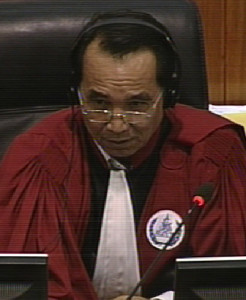
Presiding Judge Ya Sokhan
Judge Ya Sokhan announced that both documents requested by the Nuon Chea Defense Team were admitted. The Nuon Chea Defense Team had requested to admit a photograph for identity purposes that most likely taken by the photographer who enters courtroom with every witness. The request was granted before the chamber went into a break. The presiding judge Ya Sokhan announced that since the witness fell in category A of the OCIJ categories, he would have to be referred to by his pseudonym 2-TCW-1036.
At this point, the President adjourned the hearing for a break. After the lunch break, Defense Counsel Victor Koppe asked the witness when he joined the revolution. He replied that he joined in 1972. He started being a messenger in 1975, before he was transferred to Ampil Prahom in 1977 and imprisoned in that year. Mr. Koppe asked whether he was a messenger for Ruos Nhim before 1975. The witness confirmed that he had worked as a messenger for him. Mr. Koppe asked whether it was correct that he was a soldier in Pailin Province and that Ta Nhim invited the witness to be his bodyguard in 1976. There was a “close circle” around Ta Nhim and then another circle of four people around him. He denied having been part of the close circle.
He knew a messenger called Chruk. Mr. Koppe asked whether he knew Ta Ly alias Ta Khim, which the witness denied. He did not “do much” for Ruos Nhim, he said. He explained that he remained in the car while Ruos Nhim was “doing something”. Mr. Koppe read his interview, in which he had said that he followed Ruos Nhim everywhere.[8] The witness denied this and said that he only accompanied him when he went to distant places. Someone else accompanied him when he went to places that were not far away. Mr. Koppe asked whether it was correct that he stayed in a house close to Ampil Prahong, which he confirmed. They would travel by car to other places. The car, which was a white jeep, was at Ruos Nhim’s house. His house was close to the road in Ampil Prahong. Mr. Koppe asked whether he also brought him to Sisophon, which the witness confirmed.[9] He denied bringing him to Ta Pet’s house. There were two layers, and he was not allowed to enter at Ampil Prahong.
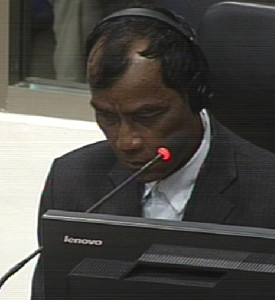
Witness s2-TCW-1036
Ruos Nhim’s Arrest
Mr. Koppe read out an excerpt of his statement, in which he had said that Ruos Nhim was arrested at the end of 1978. He said that he could not remember this and heard about it from other people. Ruos Nhim’s children were called Cheal alias Chhnang, Hor, Kong Srean, and a child whose name he could not remember. He could not remember whether there was a child called Si Suol. Cheal was stationed at Svay Sisophon. He did not know whether he had any adopted children.
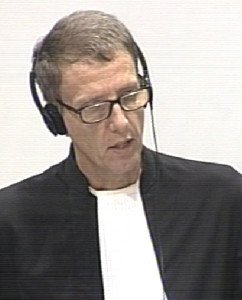
International Nuon Chea Defense Counsel Victor Koppe
Mr. Koppe then asked about Ta Ham, also called Thoeurn Toit, who was Brigade General in Royal Cambodian Armed Forced, and who died exactly two months ago today. He said that he neither saw nor knew him. Mr. Koppe asked whether he knew the person of the photograph, which showed Toit Thoeun, who had testified in June 2015. He said that he also did not know the name. Neither did he know Sao Phim.[10] Mr. Koppe showed a photograph on the screen that showed a few cadres and a person with a cap. The witness did not know him. Nor did he know the person next to him. “Have you never seen Pol Pot before?” Mr. Koppe asked. The witness said he had not.
Connections to Vietnam
Mr. Koppe said that the person called Ham had testified in the courtroom and that he had told the chamber about a marriage.[11] Mr. Koppe asked whether he brought Ruos Nhim to the wedding of his son. He could not recall.
He denied having taken him to Phnom Den Mountain near Vietnam. Another driver drove him there. Mr. Koppe read an excerpt, in which he had said that he “used to escort” Ruos Nhim to Phnom Den Mountain.[12] He again denied this. When Mr. Koppe refreshed his memory, he said he vaguely remembered. It was close to the Vietnamese border, he said. This was probably in 1977. He only went there once and separated from him in 1978. He did not know why Ruos Nhim went there.
There was a truck with uniforms that was brought there. They were not allowed to go in. The number of the truck was 32. Chruk drove him. “He was fed like pigs, that’s why he was called Chruk”. The president instructed the witness to give answer “just the way you speak at home”.
Military Uniforms
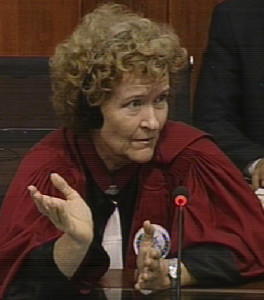
Judge Claudia Fenz
Mr. Koppe then asked about the military uniforms that were put onto the truck. The witness denied having seen any Vietnamese on this truck. Neither did he hear people speaking Vietnamese. Mr. Koppe asked about He Sor that Ta Han had mentioned.[13] Mr. Lysak objected and said that it was not clear whether the information indicated came from the confessions he read and what he knew independently of that. He did not see the man who fit Han’s description of He Sor. Mr. Koppe asked whether he thought it was not “very strange and unusual” that Ta Nhim collected military uniforms from a country Cambodia was at war with. Mr. Lysak said that at the time Cambodia was not at war at the time and that he was also asking for his opinion instead of factual findings. Mr. Koppe slightly rephrased the question slightly and asked whether he “remembered thinking” that it was unusual. Mr. Lysak objected again on the basis that it was a leading question. Mr. Koppe asked whether he considered it “highly unusual” at the time to collect uniforms in Vietnam. The witness answered that he did not know about this.
Mr. Koppe then wanted to know whether he was questioned before ultimately being sent to Koh Kor Prison. He was asked how many years he had served Ruos Nhim. He was also asked whether he was “linked to the yuon network”. He was asked this repeatedly. He said he “never saw any yuon”.[14] He was asked about the Vietnamese, but said that he did not go with him to Vietnam. He had other bodyguards who were close to Ruos Nhim. Mr. Koppe confronted the witness with a few statements that related to a potential affiliation of the Sao Phim with the Viet Cong.[15] Mr. Koppe asked whether this was something he had heard at the time. The witness denied this.
Conflict between Victor Koppe and the Judges
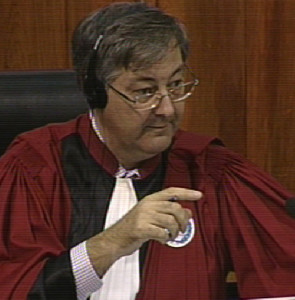
Judge Jean-Marc Lavergne
Mr. Koppe asked whether there was a “secret civil war” going on that Robert Lemkin had mentioned to journalist George Wright. When Judge Fenz prohibited him from asking this question, since the document had not been admitted, he said that “then I note that you withhold interesting information, as usual.”[16] The witness had not heard about any secret war or internal rebellion. Mr. Koppe then attempted to confront the witness with a transcript that had not been admitted. He was prohibited by the bench and shot back that they bench was withholding crucial information. Judge Lavergne said that this remarked was inappropriate, to which Mr. Koppe responded: “No it isn’t at all, Judge Lavergne. You are withholding crucial information, crucial information for the defense. The public should know what’s going on.” The presiding judge informed Mr. Koppe that he could continue his questioning. Mr. Koppe said “and thank you for cutting off my microphone on the suggestion of Judge Lavergne”. After this exchange, Mr. Koppe remarked that the presence of Vorn Vet at a meeting was established in a document that was not admitted by the chamber. Following this debate, the floor was granted to the Co-Prosecution, since the defense team had concluded their questioning.
Senior Assistant Prosecutor Dale Lysak asked whether 1960 was not his actual birth. Mr. Lysak asked where Ta Nhim was based.[17] He replied that he changed locations. One of the locations was to the south of Prey Char. The commander at the time when he was assigned to spy on Lon Nol barracks was Ta Chaem. Mr. Lysak inquired whether he knew Wat Kor, which the witness confirmed. Mr. Lysak inquired how far Wat Kor was from Ampil Prahong. “They are a bit distant from each other”, he said. Mr. Lysak asked whether the village Wat Kor was immediately to the south of Battambang, which the witness confirmed. It was on the way to Banan. Mr. Lysak read an excerpt of Nuon Chea’s driver-bodyguard.[18] He had said that Nuon Chea would meet with Ta Nhim and went to Battambang Province. They met “somewhere in a pagoda”. The witness said that this pagoda might have been War Kor, but that he did not know what he did there. The presiding judge said the pagoda was called Wat Kandal. The witness did not know the pagoda.
Judge Ya Sokhan then adjourned the hearing. It will resume tomorrow, September 22, 2016, at 9 am.
[1] 510, 511, 513, 517, 866, OCIJ List.
[2] E3/7523, at 00061163 (KH), 00875574 (EN), 00884233 (FR).
[3] E3/5149 at 00170634 (KH), 00205044-45 (EN), 00524399 (FR).
[4] E3/7523, at 00061141 (KH), 00875576-77 00884211 (FR).
[5] E3/7523, at 00061173 (KH), 00875585 (EN), 00884241 (FR).
[6] E3/7523, at 00884241 (FR), 00061173-74 (KH), 00875586 (EN).
[7] E3/7523, at 00884223 (FR), 00875576 (EN), 00061164 (KH).
[8] E3/9581, at answer 3.
[9] E3/9854, at answer 4.
[10] E3/10664, at 01156797 (EN), 01168438 (KH).
[11] E3/1065 806 (EN), 01168451 (KH); 01168447 (KH).
[12] E3/9581, at answers 3 and 4.
[13] E#/10665, at 01156805-06 (EN), 01186451-52 (KH).
[14] E3/9581, at answer 41.
[15] E3/10665, at 01156801 (EN), 01168442 (KH).
[16] E416.1.2, at 01298489.
[17] E3/9581
[18] 18 April 2012, E1/63.1, at 15:22-15:26.
Featured Image: Anonymous witness 2-TCW-1036 (ECCC: Flickr).
